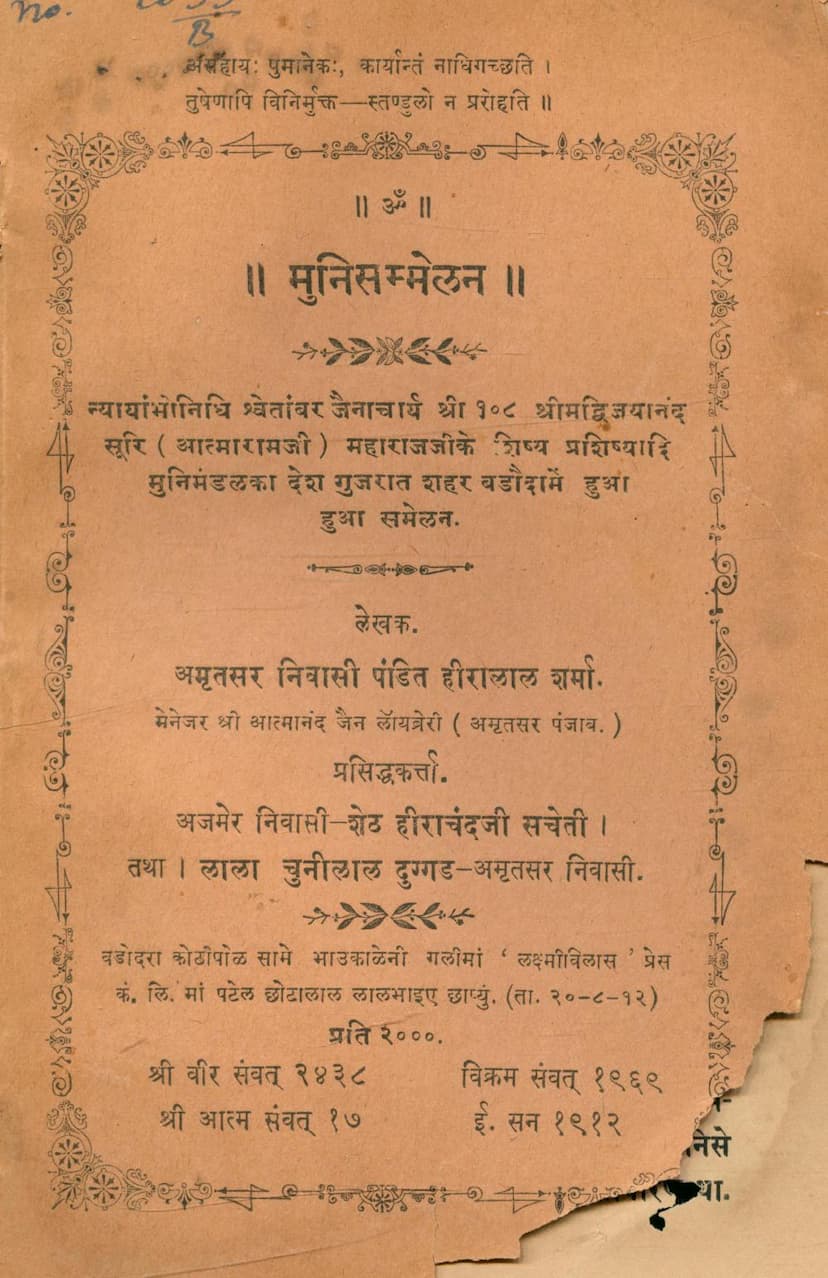Muni Sammelan 1912
Added to library: September 2, 2025

Summary
This document is a summary of the "Muni Sammelan 1912," a conference of Jain monks held in Vadodara (Baroda), Gujarat, on June 13, 1912. The book was authored by Pandit Hiralal Sharma of Amritsar and published by Seth Hirachand Sacheti of Ajmer.
The conference was presided over by Acharya Shrimad Vijaykamal Surishwarji, a disciple of the renowned Acharya Shrimad Vijayanand Surishwar (Shrimad Atmaramji) Maharaj. The event saw an assembly of over a thousand monks from various regions who had undertaken arduous journeys to attend.
The author, Pandit Hiralal Sharma, explains that the primary purpose of the conference was to foster unity and mutual recognition among the monks, facilitate discussion on religious matters, and encourage the spread of Jainism. He highlights that such gatherings were not new but a revival of ancient traditions aimed at revitalizing the duties of monks.
The conference addressed several crucial issues and passed numerous resolutions, which are detailed in the text. Some of the key proposals and discussions included:
Key Themes and Proposals:
- Unity and Dharma Propagation: The overarching theme was the need for unity among Jain monks and the effective propagation of Jain principles in a changing world.
- Conduct and Discipline of Monks:
- Chaukhmas (Monsoon Retreats): Monks were instructed to follow the directives of the Acharya regarding their Chaturmas locations.
- Vihar (Travel): Monks were encouraged to travel beyond major cities and Gujarat to preach in other regions like Marwar, Mewar, Malwa, Punjab, and Kutch, where Jainism was declining or facing challenges. The text laments that many monks prefer the comfort of cities and often stay in the same regions year after year, leading to spiritual stagnation.
- Prohibition of Dwelling in One Place: A rule was passed against spending more than one Chaturmas in the same location without a specific reason, emphasizing the importance of constant movement (vihar) for maintaining purity.
- Prohibition of Solitary Travel: Monks were discouraged from traveling alone, with a minimum of two monks required for travel, and permission from the Acharya needed if only one had to travel.
- Discipline in Following the Acharya: Strict adherence to the Acharya's instructions was emphasized, particularly regarding travel, acceptance of disciples, and conduct.
- Material Possessions: Monks were advised against possessing expensive or elaborate items, such as gold or silver-rimmed spectacles, and instead encouraged to use simpler, less costly alternatives.
- Acceptance of Disciples: Rules were laid down regarding the process of admitting new disciples, including thorough examination and informing their relatives, to prevent issues and maintain the sanctity of the initiation.
- Pilgrimages: The practice of monks spending excessive time in pilgrimage sites like Palitana, to the neglect of other regions, was criticized.
- Interaction with Laity: Monks were advised against accepting clothes directly from householders at the Upashray (monastery) but should fetch what is needed from their homes with permission. They were also encouraged to engage in public discourse and lectures to spread Jain teachings to a wider audience, including non-Jains.
- Purity of Conduct: Several proposals addressed potential breaches of conduct, such as monks aligning with displeased disciples of other monks without permission, or engaging in secret correspondence.
- Kesh-lanchan (Hair Pulling): The practice of plucking hair as per tradition was to be maintained, with shaving permitted only for medical reasons with the Acharya's permission.
- Learning and Knowledge: The importance of studying Jain scriptures, logic, and other philosophical texts was stressed. The text points out a decline in the depth of knowledge among some contemporary monks compared to their predecessors.
- Community Harmony: The importance of unity and preventing internal conflicts (kusang) among monks was a recurring theme. The example of the human hand, where each finger has a specific function and works in harmony, was used to illustrate the power of unity.
- Criticism of Malpractices: The conference explicitly condemned practices that led to the Jain religion's disrepute, such as improper disciple-making and the acceptance of costly items.
- Response to Criticisms: The text addresses a specific incident where a pamphlet by Mohanlal Lallubhai of Ahmedabad contained offensive remarks against prominent Jain saints. The conference resolved to uphold peace and forgiveness in such situations, reflecting the principle of "Kshama" (forgiveness) in Jainism. The author notes that legal action was taken against the perpetrator.
- Interfaith Engagement: The conference proposed that Jain monks should assist non-Jains who are engaged in promoting virtues like compassion, reflecting the Jain principle of "Ahimsa Paramodharma."
The author concludes by emphasizing the importance of implementing the passed resolutions and reiterates his hope for the continued progress of the Jain faith through such efforts. The book also includes testimonials from newspapers and an individual expressing their appreciation for the conference and its resolutions. The list of attending monks is also provided.